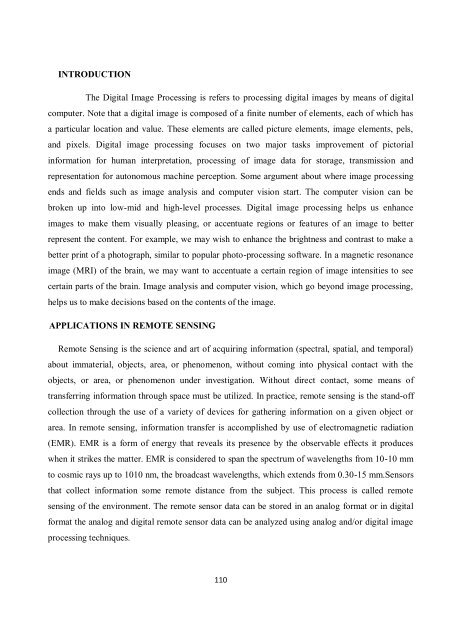combinepdf (5)
Create successful ePaper yourself
Turn your PDF publications into a flip-book with our unique Google optimized e-Paper software.
INTRODUCTION<br />
The Digital Image Processing is refers to processing digital images by means of digital<br />
computer. Note that a digital image is composed of a finite number of elements, each of which has<br />
a particular location and value. These elements are called picture elements, image elements, pels,<br />
and pixels. Digital image processing focuses on two major tasks improvement of pictorial<br />
information for human interpretation, processing of image data for storage, transmission and<br />
representation for autonomous machine perception. Some argument about where image processing<br />
ends and fields such as image analysis and computer vision start. The computer vision can be<br />
broken up into low-mid and high-level processes. Digital image processing helps us enhance<br />
images to make them visually pleasing, or accentuate regions or features of an image to better<br />
represent the content. For example, we may wish to enhance the brightness and contrast to make a<br />
better print of a photograph, similar to popular photo-processing software. In a magnetic resonance<br />
image (MRI) of the brain, we may want to accentuate a certain region of image intensities to see<br />
certain parts of the brain. Image analysis and computer vision, which go beyond image processing,<br />
helps us to make decisions based on the contents of the image.<br />
APPLICATIONS IN REMOTE SENSING<br />
Remote Sensing is the science and art of acquiring information (spectral, spatial, and temporal)<br />
about immaterial, objects, area, or phenomenon, without coming into physical contact with the<br />
objects, or area, or phenomenon under investigation. Without direct contact, some means of<br />
transferring information through space must be utilized. In practice, remote sensing is the stand-off<br />
collection through the use of a variety of devices for gathering information on a given object or<br />
area. In remote sensing, information transfer is accomplished by use of electromagnetic radiation<br />
(EMR). EMR is a form of energy that reveals its presence by the observable effects it produces<br />
when it strikes the matter. EMR is considered to span the spectrum of wavelengths from 10-10 mm<br />
to cosmic rays up to 1010 nm, the broadcast wavelengths, which extends from 0.30-15 mm.Sensors<br />
that collect information some remote distance from the subject. This process is called remote<br />
sensing of the environment. The remote sensor data can be stored in an analog format or in digital<br />
format the analog and digital remote sensor data can be analyzed using analog and/or digital image<br />
processing techniques.<br />
110




